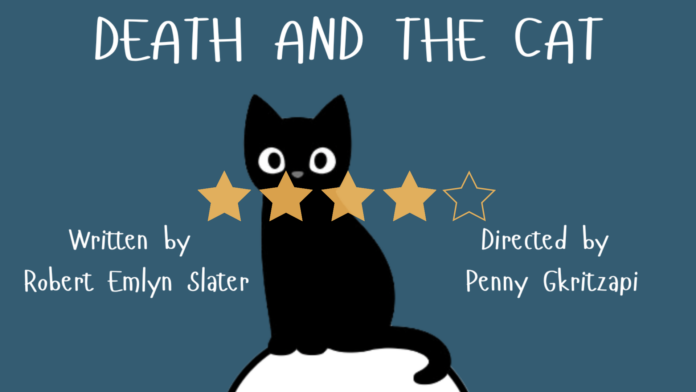★★★★
Since time immemorial, portrayals of the Grim Reaper have taken various guises, with dramaturges choosing to sidestep the scythe and cloak in favour of something subversive. From Bill and Ted’s lumbering Reaper to the undatable Death of Family Guy, to more serious fare like A Christmas Carol and The Book Thief. There’s Terry Pratchett’s depiction in Discworld, presenting Death as a sardonic figure speaking in ALL CAPS, a fan of cats and curry. In Ingmar Bergman’s The Seventh Seal, it’s a hooded entity engaging a knight in a game of chess on a mysterious beach, in Dead Like Me, it’s a troupe of “Reapers” employed in the mundane office job of summoning souls to the afterlife, in Meet Joe Black it’s Brad Pitt. Put simply, the concept of death as a sentient being, personified and modernised along with other religious figures—Satan and God among them—is something we’ve always found entertaining. Perhaps as our societies become more secular, religious deities need a bit of modernising. It makes them applicable to our quotidian lives. Death in human form remains a tantalising concept—does he (she/they?) enjoy their job? Do they ever feel conflicted about what they’re doing? Imbuing death with human characteristics raises multiple questions, so is ripe for fiction.
Joining this established pantheon is Death and the Cat, a new production from emerging writer Robert Slater. The play finds the Grim Reaper, played with devilish flair by Rowland Stirling, living alongside his pet talking cat, Panther, in a bare-bones living room made up of an armchair, a few stools and a chessboard, a possible Bergman nod. (“I wish we had an Xbox instead,” Death laments.) For centuries, they’ve guided deceased souls into the afterlife via two doors, one red, one black, positioned stage left (a smart use of the Drayton Arms Theatre’s two onstage doors, though you wonder how this will translate to a different theatre). Like our two protagonists, we’re never privy to what lies beyond those doors, though when Panther ventures past the threshold and discovers the hidden truth, this serves as a catalyst for the play’s main action. Bitter about losing his oldest friend when a horrified Panther runs away, Death goes rogue and all Hell breaks loose—quite literally.
Influences from previous works abound, namely The Master and Margarita in which the supernatural and the satirical are neatly merged as Satan and his entourage, anthropomorphic cat included, lay siege on modern-day Moscow. There’s some of Kevin Smith’s Dogma here too and more recently, the Netflix series Kaos. The concept isn’t exactly original, but in the hands of this nine-strong ensemble and their talented production crew, Death and the Cat is a supremely enjoyable show that rarely lets up. The script is sharp, the characterisation clear. The cast sink their teeth into their roles and extract every comedic ounce from the material. The audience is primed for the arrival of certain characters before they appear, so it’s a lot of fun seeing how Slater and director Penny Gkritzapi will choose to present each deity. Having Satan as a West London party girl sporting a ‘The Hot Mess Club’ shirt, or heralding God’s arrival with refrains of Beyonce’s ‘Halo’ are inspired creative choices. These moments encourage the audience to play a guessing game, wondering how the Slater-verse will introduce the next larger-than-life character.
A tightly-paced first act gives way to a slightly more uncertain second one. The two-hour runtime feels excessive for a satire of this kind and could benefit from some trimming. Still, despite its silliness, the play manages to deal tactfully with its more solemn subject matter of the grim reality of death as the only certainty. When Panther befriends a terminally ill woman enjoying her last holiday, there’s a poignancy to it that could belong to a more dramatic text. Other scenes question the binary simplicity of Heaven vs Hell—as one character is whisked via taxi towards his impending doom and demands to know why, Death bluntly responds: “You’re not evil, you’re just not that good.” It’s interesting that in a play bordering on farcical so frequently, it does venture into these places, querying how so many religions can water the complexities of human experience into two crude categories. Red door or black? Death being a character, the theme of death is everywhere, and the play’s handling of its more complicated topics turns out to be fairly dextrous.
It’s light-hearted where it needs to be and the cast are clearly having a lot of fun. It’s not on for long but worth a watch: Death and the Cat is a stellar addition to anyone’s bucket list.
Death and the Cat will be performed at Drayton Arms Theatre until 30 November.
Words by James Morton
Support The Indiependent
We’re trying to raise £200 a month to help cover our operational costs. This includes our ‘Writer of the Month’ awards, where we recognise the amazing work produced by our contributor team. If you’ve enjoyed reading our site, we’d really appreciate it if you could donate to The Indiependent. Whether you can give £1 or £10, you’d be making a huge difference to our small team.
